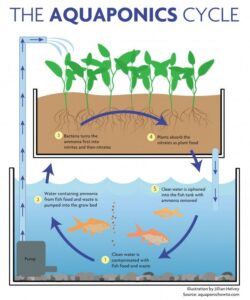How fish, bacteria, and plants create a self-sustaining ecosystem that saves water and boosts food security.

Aquaponics is more than just a farming technique—it’s a living ecosystem where plants, fish, and bacteria work in perfect balance. The diagram of The Aquaponics Cycle shows how this process transforms fish waste into plant food while cleaning water for the fish. It’s an elegant, closed-loop system that mirrors the natural cycles found in rivers and wetlands, but designed for human use in homes, farms, and even cities.
Let’s break it down step by step:
1️⃣ Fish Waste Creates the First Link
In the fish tank, fish live and grow, producing waste as they eat. This waste, rich in ammonia, is the starting point of the cycle. While ammonia is toxic to fish in high levels, it becomes an essential nutrient once transformed. The contaminated water is continuously cycled out of the tank to begin the purification process.
2️⃣ Pumping Water into the Grow Bed
A pump carries the fish waste-filled water into the grow bed above. This is where the magic happens. The grow bed contains a medium (like gravel or clay pebbles) that provides surface area for beneficial bacteria to live. Here, the transformation of waste into plant nutrients begins.
3️⃣ Bacteria Convert Ammonia into Plant Food
Inside the grow bed, colonies of nitrifying bacteria break down the fish waste.
- First, bacteria convert ammonia into nitrites.
- Then, a second group of bacteria turns nitrites into nitrates.
Nitrates are far less toxic to fish and are exactly what plants crave as fertilizer. This step is the biological heart of the system, proving that microbes are just as important as fish and plants in aquaponics.
4️⃣ Plants Absorb Nutrients and Grow
With nitrates now available, plants use them as plant food. Their roots absorb the nutrients dissolved in the water, fueling rapid and healthy growth. Leafy greens like lettuce, spinach, and herbs thrive, while even fruiting crops such as tomatoes and peppers benefit.
By taking in nitrates and other minerals, plants not only grow faster but also act as a filter, cleaning the water naturally.
5️⃣ Clean Water Returns to the Fish Tank
Once the plants have absorbed the nutrients, the water—now purified and free of toxic ammonia—is siphoned back into the fish tank. This creates a continuous recycling loop where the same water is used again and again, drastically reducing waste.
🌱 Why Aquaponics Works So Well
Aquaponics works because it imitates nature’s own systems:
- Fish provide waste that becomes fertilizer.
- Bacteria act as recyclers, turning harmful compounds into usable nutrients.
- Plants absorb those nutrients, cleaning the water.
- Clean water sustains the fish, closing the loop.
This cycle can go on indefinitely with minimal outside input, creating a highly sustainable food production method.
🌎 Environmental and Social Benefits
- Water Conservation: Uses up to 90% less water compared to traditional farming.
- Dual Harvest: Provides both protein (fish) and vegetables.
- No Chemicals: Relies on natural bacteria and plant uptake, avoiding synthetic fertilizers.
- Urban Friendly: Can be set up in warehouses, rooftops, or backyards, making it ideal for cities.
🧪 Conclusion
The aquaponics cycle is a living demonstration of how biology, ecology, and design can come together to solve global food challenges. By following this natural cycle, we not only reduce waste and conserve water but also ensure a steady, sustainable supply of food.
It’s not just farming—it’s nature’s wisdom applied to modern living.